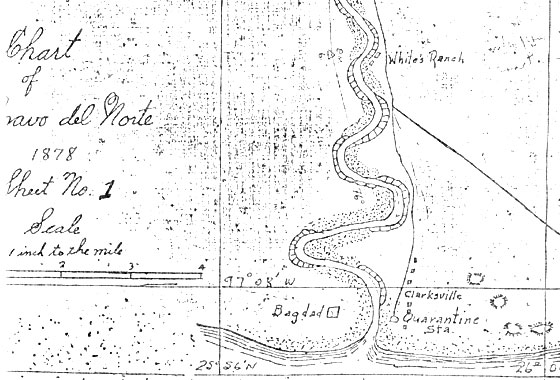Clarksville
Clarksville was a small community located near the northern edge of the mouth of the Rio Grande opposite Bagdad. Founded during the 1840s, Clarksville served as a staging area for U.S. troops during the Mexican American War. Early in the Civil War, Clarksville prospered because of the cotton trade and presence of Confederate blockade-runners. In 1863, however, the area was captured and occupied by Union forces, which seized private homes and warehouses and caused most residents to flee. As part of emperor Maximilian’s efforts to suppress Mexican resistance, French gunboats occasionally shelled Clarksville. Theresa Clark Clearwater, daughter of the town's founder, recalled that "often the families were forced to take refuge behind some big sand hill during these bombardments." Troops of the Texas Confederate Calvary, as well as French and Austrian soldiers from Maximilian’s forces also frequented Clarksville. In 1866, American filibusters, private soldiers of fortune, attacked Maximilian's imperial forces at neighboring Bagdad with the help of black soldiers from the 118th U.S. Colored Infantry. The great hurricane of 1867 killed many residents and caused heavy damage to Clarksville, but the community survived. In 1872, the building of a railway from Brownsville to Port Isabel diverted commerce away from Clarksville, which was damaged again by storms in 1874 and 1886. Eventually, the little community ceased to exist, and a change in the course of the Rio Grande in 1953 resulted in the river flowing over the old site.
Listen
Esta pequeña comunidad se localizaba cerca del extremo septentrional de la desembocadura del Río Grande, frente a la ciudad de Bagdad. Fundada en la década de 1840, Clarksville sirvió como zona de tránsito para las tropas estadounidenses durante la Guerra Méxicoestadounidense o Guerra de Intervención. A principios de la Guerra de Secesión, el comercio de algodón y la presencia de contrabandistas confederados que burlaban el bloqueo hizo prosperar la localidad, pero en 1863 la zona fue tomada y ocupada por las fuerzas unionistas, que confiscaron viviendas privadas y almacenes, haciendo que la mayor parte de los residentes se dieran a la fuga. Como parte de los esfuerzos del emperador Maximiliano por suprimir la resistencia mexicana, cañoneras francesas bombardeaban ocasionalmente el pueblo. Theresa Clark Clearwater, hija del fundador del mismo, recodaba cómo «las familias se veían obligadas con frecuencia a buscar resguardo detrás de una duna grande durante aquellos cañoneos». Las fuerzas de la Caballería Confederada de Texas, así como soldados franceses y austriacos de las fuerzas de Maximiliano, también frecuentaban el lugar. En 1866, filibusteros estadounidenses, mercenarios y soldados de fortuna, atacaron a las tropas imperiales en la vecina localidad de Bagdad, con la ayuda del 118 Regimiento Negro de Infantería del Ejército de los Estados Unidos. El gran huracán de 1867 acabó con las vidas de muchos de los residentes y causó grandes pérdidas en Clarksville, pero la comunidad sobrevivió. En 1872, no obstante, la construcción de una línea de ferrocarril entre Brownsville y Puerto Isabel desvió el flujo comercial apartándolo de Clarksville, que fue castigado de nuevo por las tormentas de 1874 y 1886. En último término, la pequeña comunidad dejó de existir, y un cambio en el curso del Río Grande en 1953 causó la inundación permanente del antiguo emplazamiento.
Escucha
Details
Location: Small community located near the mouth of the Rio Grande River opposite Bagdad. A change in the course of the Rio Grande River in 1953 resulted in the river flowing over the old site.

